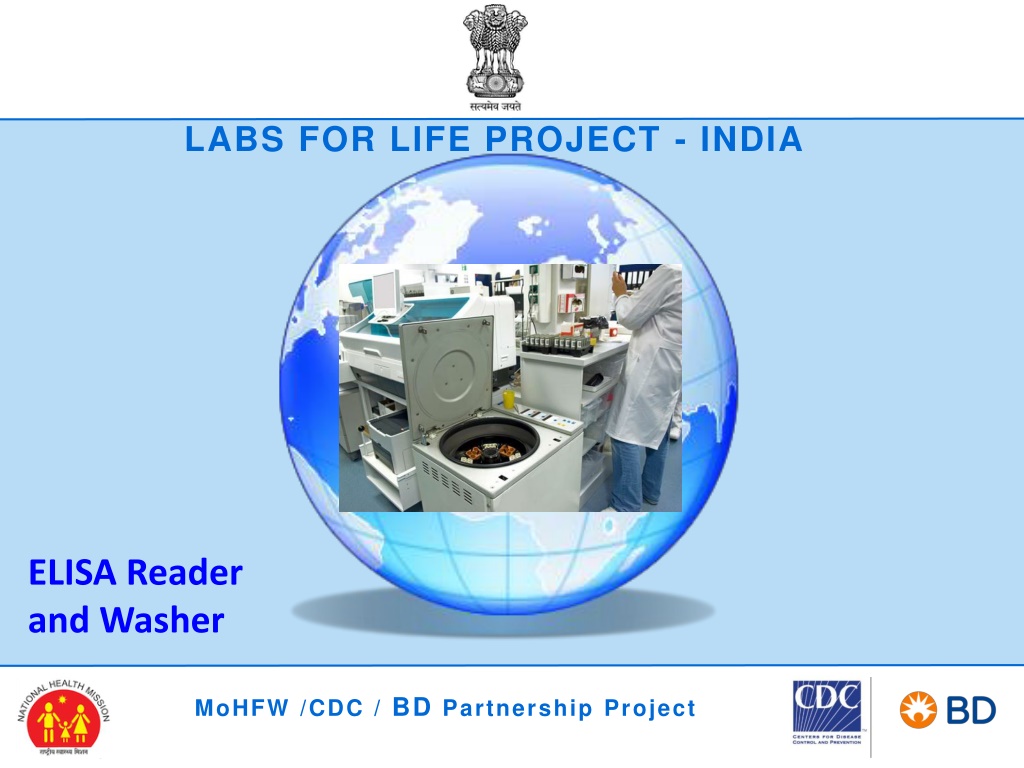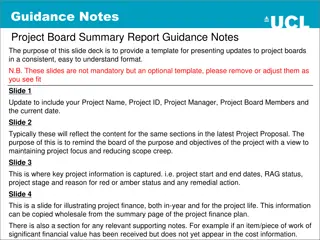LABS FOR LIFE PROJECT - INDIA
The LABS.FOR.LIFE.PROJECT in India focuses on immunoassays using ELISA technology for measuring hormones, drugs, and serological markers. The project involves different formats of immunoassays like Sandwich, Competitive, Indirect, and Two-Step Immuno-capture. Various steps involved in immunoassays and the equipment used, such as Micro-plate ELISA Washer and Reader are highlighted.
Download Presentation
Please find below an Image/Link to download the presentation.
The content on the website is provided AS IS for your information and personal use only. It may not be sold, licensed, or shared on other websites without obtaining consent from the author. Download presentation by click this link. If you encounter any issues during the download, it is possible that the publisher has removed the file from their server.
Presentation Transcript
LABS FOR LIFE PROJECT - INDIA ELISA Reader and Washer MoHFW /CDC / BD Partnership Project
Analyzers for Immunoassay Principle/Purpose Immunoassays are based on antigen antibody reactions. Immunoassays are used for measurement of hormones, drugs and serological markers etc. Various immuno-detection Immunoassays Radioactive no more used! Enzyme Labeled Antibodies ELISA (Enzyme-Linked-Immunosorbant-Assay) Chemiluminescence Fluorescence markers are used in
Classification and formats of Immunoassays Immunoassays can be run in a number of different formats. Generally, an immunoassay will fall into one of several following categories depending on how these are performed. 1. 2. 3. 4. Sandwich Assays Competitive Immunoassays Indirect Assays Immuno-capture Assays
Sandwich Assay (viz. TSH) Goat anti- mouse IgG Goat anti-TSH alk phos conjugate MAb anti-TSH Solid Phase Sample containing TSH + + 36.5 C Wash steps
Competitive Assay (viz. T4) T4 alk phos conjugate Sample containing T4 Goat anti- mouse IgG + MAb anti-T4 + + Wash steps 37 C 37 C
Indirect Assay (viz. Rub IgG) PMP Rubella virus Sample containing IgG anti-rubella antibodies + + MAb anti- human IgG alk phos conjugate Wash steps Wash steps
Two-Step Immuno-capture Assay (viz. Rub IgM) + Sample containing Anti-Rubella IgM + PMP anti- human IgM PAb Wash steps Rubella Ag- Anti-Rubella MAb Alkaline Phosphatase Wash steps Complexes
Usual Steps In Immunoassays Washing to remove unbound materials Promote binding - Incubation Addition of reagent to create signal Detection of signal Incubation to promote signal generation Pipetting of Sample, Reagents Micro-plate ELISA: The above-depicted steps are carried out 96 well Micro-plates
Analyzers used for ELISA Assay Micro-plate ELISA Washer Micro-plate ELISA Reader Automated ELISA Processor
ELISA Readers Based on Photometric Principle ELISA photometric following features Ability to take photometric readings on individual well in microplate The optics (light source and detector) mounted Similar to photometer, ELISA readers are controlled Various analyte programs can be pre-programmed in the reader Calibration, control usually stored memory readers are special with analyzer are vertically microprocessor data on-board can in
Achieving Maximum Performance of ELISA Readers 1. Microplate should be clean and free of dust or scratches at the bottom Accuracy of pipetting has huge impact on results. The micro-well should have minimum 100ul of liquid for better results The inclination of the meniscus can cause loss of accuracy, especially with small volumes, agitate the microplate before reading 2. 3. 4. Maintenance: ELISA readers require minimal user-maintenance. Routine user- performed maintenance is confined to keeping the microplate carriage area clean of any spillage and dust. Decontamination is recommended using 0.5% bleach solution
Microplate ELISA Washers Microplate washing is one of the most critical step in ELISA procedure Inadequate or non-uniform washing step could lead to major errors in accuracy and precision The washers are micro-processor controlled and volume of wash, time duration of cycle can be programmed
Microplate ELISA Washers Automated plate washer employs eight pairs of tubes. a. One set for dispensing wash solution b. Other set to aspirate the contents
Preventive Maintenance micro-plate Washer General routine maintenance includes Rinsing and soaking the fluid path and cleaning the washer s various components. Following table suggests usual maintenance schedule Task Daily Overnight Weekly Monthly Prolonged shutdown Rinse fluidic lines Empty waste bottle Clean Bottles Clean Plate Carrier system Clean wash manifold Decontaminate external surfaces
Preventive Maintenance Cleaning of washer 1. Cleaning the washer components on a regular basis is critical to keep the washer running efficiently 2. The recommended frequency for cleaning washer components is at least monthly. 3. Non-compliance to this may lead to improper washing and contamination and carry over
IMMUNOASSAY ANALYSERS - Instrumentation Major Parts of IMMUNOASSAYAnalyser
IMMUNOASSAY ANALYSERS Cobas e 411 IMMUNOASSAYAnalyser
IMMUNOASSAY ANALYSERS Cobas e 411 IMMUNOASSAYAnalyser
IMMUNOASSAY ANALYSERS Cobas e 411 IMMUNOASSAYAnalyser
IMMUNOASSAY ANALYSERS Cobas e 411 IMMUNOASSAYAnalyser
IMMUNOASSAY ANALYSERS Major Parts of IMMUNOASSAYAnalyser
IMMUNOASSAY ANALYSERS Major Parts of IMMUNOASSAYAnalyser
IMMUNOASSAY ANALYSERS Calibration of Tests Similar to clinical chemistry, the calibration of chemiluminescence tests may be single point (using single calibrator) or multiple calibrators. However, most of the assays may use up to six calibrators. This is because unlike clinical chemistry the immunoassay reactions usually follow a non-linear pattern. The calibration frequency and stability is assay and analyzer dependent. The users must be aware of reagent and equipment manufacturer s recommendations for calibration. Most of chemiluminescence analyzers in use in the country are closed systems (only allow manufacturer s reagents), which offers uniformity of practices and performance. The fully automated analyzers have an on-board ability to monitor calibration stability and highlight when it is time for re-calibration of tests. The users must ensure that the manufacturers recommendations are followed.
IMMUNOASSAY ANALYSERS Calibration Verification Unlike clinical Chemistry Analysers, Calibration must always be followed by re-running of quality control samples in order to ensure acceptable performance.
IMMUNOASSAY ANALYSERS MAINTENANCE Daily Maintenance of IMMULITE: Check Printer Paper Check the 2 Litre Water Container & REFILL if required Check Probe Wash Container. Replace if Required Check Fluidic Bottle levels from Detection window & from LED Indicator EMPTY Waste Tighten Syringes/Thumb Screws Prime the Syringes Check SUBSTRATE Bottle and level. Replace if required Check Substrate Dispensing Nozzle & Prime the Substrate & Water Pumps Clean the PROBE
IMMUNOASSAY ANALYSERS MAINTENANCE Weekly Maintenance of IMMULITE: Clean the Instrument FAN Filter on the right side of Instrument Clean the Computer Fan & Filter on the front of the Instrument
IMMUNOASSAY ANALYSERS MAINTENANCE Two Weekly Maintenance of IMMULITE: Clean the Water Bottle & Cap with 70% isopropyl alcohol followed by rinsing with distilled water thoroughly to prevent growth of algae and Bacteria.
IMMUNOASSAY ANALYSERS MAINTENANCE Monthly Maintenance of IMMULITE: sample pipetting area Change Substrate SPIKE Change small syringe TIP Decontaminate the system Test the Water for contamination Clean Probe Wash Bottle Clean the Load Platform, Sample Collection Tray and Refer to Page 8.7 of Operator Manual for Detailed description of above procedures
IMMUNOASSAY ANALYSERS MAINTENANCE Daily Maintenance of Cobas :
IMMUNOASSAY ANALYSERS MAINTENANCE Weekly Maintenance of Cobas :
IMMUNOASSAY ANALYSERS MAINTENANCE Two - Weekly Maintenance of Cobas :
IMMUNOASSAY ANALYSERS MAINTENANCE Two - Month Maintenance of Cobas :
IMMUNOASSAY ANALYSERS MAINTENANCE As needed Maintenance of Cobas :
IMMUNOASSAY ANALYSERS MAINTENANCE Logs

















































